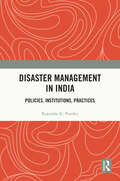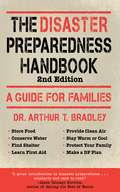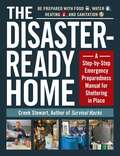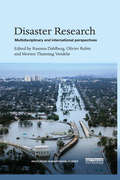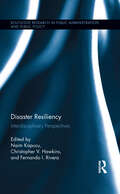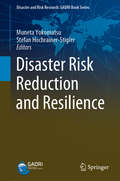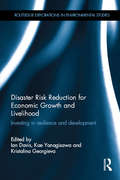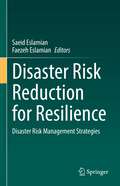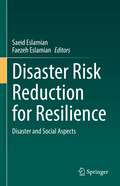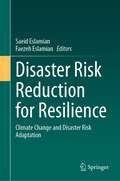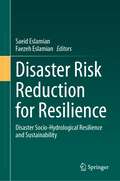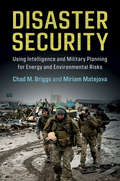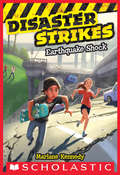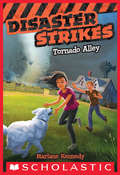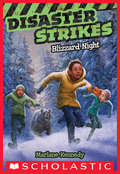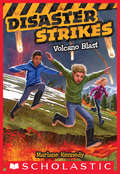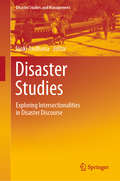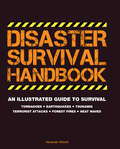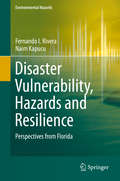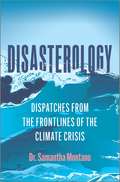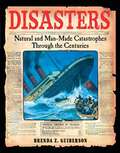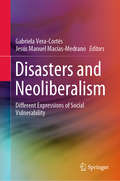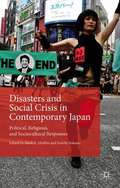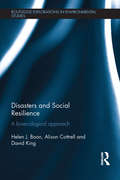- Table View
- List View
Disaster Management in India: Policies, Institutions, Practices
by Rajendra K. PandeyThis book explores policies, structures, and processes of disaster management in India examining key theoretical foundations of disaster management with practical illustrations and case studies. The book offers a comprehensive understanding of disaster management policies and practices in India and focuses on public policy approaches in addressing critical issues and challenges facing the machinery and processes of disaster management in India. The creative approach to deal with different aspects of disaster management has helped in holistic delineation of a number of critical themes such as legal frameworks of disaster management, good practices, use of innovative approaches and technology, multilateral cooperation, the role of civil society organisations, among others. This book will be of interest to the students and researchers working in the field of disaster studies, geography, geology, development studies, public administration, public policy, economics, and governance. It will also be an invaluable companion for policy makers, practitioners, academicians and development planners working in the area of disaster management.
The Disaster Preparedness Handbook: A Guide for Families
by Arthur T. BradleyNinety-nine percent of the time, the world spins like a top, the skies are clear, and your refrigerator is full of good food. But the world is a volatile place—storms rage, fires burn, and diseases spread. No one is ever completely safe. Humans live as part of a very complex ecosystem that is unpredictable and merciless. Could you protect your family in the case of an emergency—domestic or global?The Disaster Preparedness Handbook will help you to establish a practical disaster plan for your entire family (covering all fourteen basic human needs) in case the unpredictable happens. Additional information is also presented for those with special needs, including the elderly and disabled, children, pregnant women, and even pets. Well-researched by an army veteran and current NASA engineer, this is the essential guide every family should have, study, and keep handy, in case the unthinkable should occur.
The Disaster-Ready Home: A Step-by-Step Emergency Preparedness Manual for Sheltering in Place
by Creek StewartA complete, step-by-step manual for safely sheltering-in-place at home so you are prepared for any disaster or disease.If a disaster forces you to shelter in place, do you think you have everything you need to safely and comfortably stay put in your home? If the answer is no, The Disaster-Ready Home will help you create a safe, well-stocked place to weather out any emergency. Survival expert and bestselling author Creek Stewart gives you a step-by-step emergency preparedness plan to meet your food, water, heat, and sanitation needs during any disaster. Including detailed lists, photographs, and complete instructions to make the plan easy to follow, this book is the only resource you need for a disaster. You&’ll learn how to: -Create an emergency pantry stocked with enough food for the timeframe of your choice—from two weeks to three months to a full year -Select and store food that fits your taste, diet, and budget -Easily rotate and use your emergency food supply, so nothing goes to waste -Set up long-term water storage and renewable water sources -Cook food and boil water when your kitchen appliances aren&’t working -Safely heat and light your home when the power is out -Effectively manage sanitation issues if running water is unavailable -And much more! With daily headlines dominated by disease and disasters, the need to be prepared has never been more evident. This practical, field-tested guide will help you protect and provide for your family when any situation arises.
Disaster Research: Multidisciplinary and International Perspectives (Routledge Humanitarian Studies)
by Olivier Rubin Rasmus Dahlberg Morten Thanning VendeløGiven the tendency of books on disasters to predominantly focus on strong geophysical or descriptive perspectives and in-depth accounts of particular catastrophes, Disaster Research provides a much-needed multidisciplinary perspective of the area. This book is is structured thematically around key approaches to disaster research from a range of different, but often complementary academic disciplines. Each chapter presents distinct approaches to disaster research that is anchored in a particular discipline; ranging from the law of disasters and disaster historiography to disaster politics and anthropology of disaster. The methodological and theoretical contributions underlining a specific approach to disasters are discussed and illustrative empirical cases are examined that support and further inform the proposed approach to disaster research. The book thus provides unique insights into fourteen state-of-the-art disciplinary approaches to the understanding of disasters. The theoretical discussions as well as the diverse range of disaster cases should be of interest to both postgraduate and undergraduate students, as well as academics, researchers and policymakers.
Disaster Resiliency: Interdisciplinary Perspectives (Routledge Research in Public Administration and Public Policy)
by Naim Kapucu V. Hawkins Christopher I. Rivera FernandoNatural disasters in recent years have brought the study of disaster resiliency to the forefront. The importance of community preparedness and sustainability has been underscored by such calamities as Hurricane Katrina in 2005 and the Japanese tsunami in 2011. Natural disasters will inevitably continue to occur, but by understanding the concept of resiliency as well as the factors that lead to it, communities can minimize their vulnerabilities and increase their resilience. In this volume, editors Naim Kapucu, Christopher V. Hawkins, and Fernando I. Rivera gather an impressive array of scholars to provide a much needed re-think to the topic disaster resiliency. Previous research on the subject has mainly focused on case studies, but this book offers a more systematic and empirical assessment of resiliency, while at the same time delving into new areas of exploration, including vulnerabilities of mobile home parks, the importance of asset mapping, and the differences between rural and urban locations. Employing a variety of statistical techniques and applying these to disasters in the United States and worldwide, this book examines resiliency through comparative methods which examine public management and policy, community planning and development, and, on the individual level, the ways in which culture, socio-economic status, and social networks contribute to resiliency. The analyses drawn will lead to the development of strategies for community preparation, response, and recovery to natural disasters. Combining the concept of resiliency, the factors that most account for the resiliency of communities, and the various policies and government operations that can be developed to increase the sustainability of communities in face of disasters, the editors and contributors have assembled an essential resource to scholars in emergency planning, management, and policy, as well as upper-level students studying disaster management and policy.
Disaster Risk Reduction and Resilience (Disaster and Risk Research: GADRI Book Series)
by Muneta Yokomatsu Stefan Hochrainer-StiglerThis book provides insight on how disaster risk management can increase the resilience of society to various natural hazards. The multi-dimensionality of resilience and the various different perspectives in regards to disaster risk reduction are taken explicitly into account by providing studies and approaches on different scales and ranging from natural science based methods to social science frameworks. For all chapters, special emphasis is placed on implementation aspects and specifically in regards to the targets and priorities for action laid out in the Sendai Framework for Disaster Risk Reduction. The chapters provide also a starting point for interested readers on specific issues of resilience and therefore include extensive reference material and important future directions for research.
Disaster Risk Reduction for Economic Growth and Livelihood: Investing in Resilience and Development (Routledge Explorations in Environmental Studies)
by Ian Davis Kae Yanagisawa Kristalina GeorgievaThe prevalence of natural disasters in recent years has highlighted the importance of preparing adequately for disasters and dealing efficiently with their consequences. This book addresses how countries can enhance their resilience against natural disasters and move towards economic growth and sustainable development. Covering a wide range of issues, it shows how well thought-out measures can be applied to minimize the impacts of disasters in a variety of situations. Starting with the need for coping with a rapidly changing global environment, the book goes on to demonstrate ways to strengthen awareness of the effectiveness of preventive measures, including in the reconstruction phase. The book also covers the roles played by different actors as well as tools and technologies for improved disaster risk reduction. It focuses on a variety of case studies from across Asia, Africa and Latin America, drawing out lessons that can be applied internationally. This book will be of great interest to professionals in disaster management, including national governments, donors, communities/citizens, NGOs and private sector. It will also be a highly valuable resource for students and researchers in disaster management and policy, development studies and economics.
Disaster Risk Reduction for Resilience: Disaster Risk Management Strategies
by Saeid Eslamian Faezeh EslamianThis book is part of a six-volume series on Disaster Risk Reduction and Resilience. The series aims to fill in gaps in theory and practice in the Sendai Framework, and provides additional resources, methodologies and communication strategies to enhance the plan for action and targets proposed by the Sendai Framework. The series will appeal to a broad range of researchers, academics, students, policy makers and practitioners in engineering, environmental science and geography, geoscience, emergency management, finance, community adaptation, atmospheric science and information technology. This volume offers the international guidelines and global standards for resilient disaster risk reduction and lessons learned from disasters, particularly the COVID-19 and Cholera pandemics. A resilient health system and an effective disaster risk management Index are then suggested. The book further emphasizes urban resilience strategies with local authorities, adaptation strategies for urban heat at regional, city and local scales, and lessons from community-level interventions. Also addressed are coastal erosion, displacement and resettlement strategies. Land use planning and green infrastructure are suggested as tools for natural hazards reduction. Human security in times of climate change and urban heat at regional, city and local scales is discussed for an integrated action, with case studies based in Manila, Burkina Faso, Chad, Mauritania, Niger, Senegal, Nigeria, India, Spain, and Ghana. Structure design for cascading disasters resulting from mining and flooding is presented and sustainable smart city planning using spatial data is recommended.
Disaster Risk Reduction for Resilience: Disaster and Social Aspects
by Saeid Eslamian Faezeh EslamianThis book is part of a six-volume series on Disaster Risk Reduction and Resilience. The series aims to fill in gaps in theory and practice in the Sendai Framework and provides additional resources, methodologies, and communication strategies to enhance the plan for action and targets proposed by the Sendai Framework. The series will appeal to a broad range of researchers, academics, students, policy makers, and practitioners in engineering, environmental science, geography, geoscience, emergency management, finance, community adaptation, atmospheric science and information technology.This volume provides a holistic approach to developing disaster risk reduction strategies and policies, exploring the most effective ways to integrate physical and social science aspects of hazard resilience to better inform local populations. This risk-based approach to community resilience development is used to craft a collaborative system for crisis management, and allows for the implementation of nationally determined contributions (NDCs) through social innovation and community engagement to enhance community emergency response support and preparedness. Readers will also learn about education of disaster risk reduction, human health risk assessment, gendered perspectives in disaster response, recovery, and disaster management legislation.
Disaster Risk Reduction for Resilience: Climate Change and Disaster Risk Adaptation
by Saeid Eslamian Faezeh EslamianThis book is part of a six-volume series on Disaster Risk Reduction and Resilience. The series aims to fill in gaps in theory and practice in the Sendai Framework, and provides additional resources, methodologies, and communication strategies to enhance the plan for action and targets proposed by the Sendai Framework. The series will appeal to a broad range of researchers, academics, students, policy makers, and practitioners in engineering, environmental science and geography, geoscience, emergency management, finance, community adaptation, atmospheric science, and information technology.This volume offers indigenous approaches to disaster risk reduction, community sustainability and climate change resilience, as well as agro-ecological innovations for improving resilience to climate change. The focus is on adaptation strategies for sustainable terrestrial and marine ecosystems to reduce the impacts of anthropogenic factors that exacerbate disaster risk, including hydro-meteorological services for climate resilience, food security measures in agriculture and livestock, flood mitigation plans, and increased climate change education and awareness. The book concludes with three case studies in Africa detailing the impacts of strengthened climate change resilience measures, adaptive social protections, and improved water availability through hydro-electric technologies.
Disaster Risk Reduction for Resilience: Disaster Socio-Hydrological Resilience and Sustainability
by Saeid Eslamian Faezeh EslamianThis book is part of a six-volume series on Disaster Risk Reduction and Resilience. The series aims to fill in gaps in theory and practice in the Sendai Framework, and provides additional resources, methodologies and communication strategies to enhance the plan for action and targets proposed by the Sendai Framework. The series will appeal to a broad range of researchers, academics, students, policy makers and practitioners in engineering, environmental science and geography, geoscience, emergency management, finance, community adaptation, atmospheric science and information technology.This volume discusses the implementation of socio-hydrological resilience measures to curb the impacts on vulnerable communities of hydrologic diasters such as coastal floods, drought, water scarcity, and thunderstorms. The book provides a framework for sustainable hydrology-community interactions to inform local communities about the best practices to achieve hydrological resilience, and to implement resilient water infrastructure. Hydrological influences on the resilience of a region are comprehensively surveyed, and a "green economy strategy" is described and recommended for achieving climatic and hydrological sustainability.
Disaster Security: Using Intelligence and Military Planning for Energy and Environmental Risks
by Chad M. Briggs Miriam MatejovaThis book is for a broad audience of practitioners, policymakers, scholars, and anyone interested in scenarios, simulations, and disaster planning. Readers are led through several different planning scenarios that have been developed over several years under the auspices of the US Department of Energy, the US Air Force, and continued work at GlobalInt LLC. These scenarios present different security challenges and their potential cascading impacts on global systems - from the melting of glaciers in the Andes, to hurricanes in New York and Hawaii, and on to hybrid disasters, cyberoperations and geoengineering. The book provides a concise and up-to-date overview of the 'lessons learned', with a focus on innovative solutions to the world's pressing energy and environmental security challenges.
Disaster Strikes #1: Earthquake Shock (Disaster Strikes #1)
by Marlane KennedyWhen disaster strikes, the only thing you can count on is yourself! It had seemed like the perfect California day. But as Joey Flores walked home from the skate park with his friends, the ground began to tremble, and Joey knew they were headed for trouble.... The earthquake that followed devastated their neighborhood, collapsing a nearby overpass with Joey and Fiona on one side and Kevin and Dylan on the other. Now Joey and his friends must rescue each other, endure the aftershocks, and find a new way home as the earth cracks beneath their feet.
Disaster Strikes #2: Tornado Alley (Disaster Strikes #2)
by Marlane KennedyWhen disaster strikes, the only thing you can count on is yourself! Wyatt Anderson isn't thrilled that his prissy cousin is visiting his family's Oklahoma ranch. But it turns out Wyatt has bigger problems to deal with when a pair of dueling tornadoes lock the prairie in their sights.... Wyatt, Alison, and neighbors Joshua and Jackson have nowhere to run. And when the old barn is battered by the tornadoes' ferocious winds, the animals that live inside are in danger. Will Wyatt and his friends risk their own lives to protect them?
Disaster Strikes #3: Blizzard Night (Disaster Strikes #3)
by Marlane KennedyWhen disaster strikes, the only thing you can count on is yourself! A winter trip in the remote Michigan wilderness seemed like the perfect way for Jayden to get to know his new foster family. Though he doesn't have much in common with siblings Maggie and Connor, he's hoping they'll get to like each other over snow mobile races and steaming mugs of cocoa. But when the snow really starts to come down, the family van crashes and the three kids must go out into the bleak, white storm to search for help. Soon the wind is howling and night is starting to fall. Jayden, Maggie, and Connor will have to think fast, find shelter, watch out for bears, and somehow stay warm if they don't want to end up frozen in their tracks....
Disaster Strikes #4: Volcano Blast (Disaster Strikes #4)
by Marlane KennedyWhen disaster strikes, the only thing you can count on is yourself! Noah and Emma Burton have traded the sand and surf of their Hawaiian home for a chilly stay in Alaska, and Noah isn't happy about it. His father may be a volcano expert, but why did they have to travel to the coldest, grayest place on earth when there are millions of volcanoes near Honolulu? Noah thinks he's in for the most boring vacation of his life. He couldn't have been more wrong! A day trip to a remote island turns deadly when a once-dormant volcano suddenly sputters to life in an eruption of epic proportions. Now Noah, Emma, and their new neighbor Alex must fight to survive rivers of molten lava and clouds of toxic ash if they want to make it off the island alive....
Disaster Studies: Exploring Intersectionalities in Disaster Discourse (Disaster Studies and Management)
by Janki AndhariaThis book covers several dimensions of disaster studies as an emerging discipline. It is the inaugural book in the series ‘Disaster Studies and Management’ and deals with questions such as “Is disaster management a field of practice, a profession, or simply a new area of study?” Exploring intersectionalities, the book also examines areas of research that could help enhance the discourse on disaster management from policy and practice perspectives, revisiting conventional event-centric approaches, which are the basis for most writings on the subject. Several case studies and comparative analyses reflect a critical reading of research and practice concerning disasters and their management. The book offers valuable insights into various subjects including the challenge of establishing inter- and multi-disciplinary teams within the academia involved in disaster studies, and sociological and anthropological readings of post-disaster memoryscapes. Each of the contributors has an enduring interest in disaster studies, thus enriching the book immensely. This book will be of interest to all the students and scholars of disaster studies and disaster management, as well as to practitioners and policymakers.
Disaster Survival Handbook: An Illustrated Guide to Survival
by Alexander StilwellA practical and illustrated guide to getting through all types of life-threatening situations.Are you ready for the big one, whether it’s an earthquake, a hurricane, or a monster snowstorm? Disaster Survival Handbook will help you prepare for the unexpected—from stocking up on provisions to hunkering down in a safe area to administering basic first aid. The power of nature means that disasters are inevitable and that surviving them is all about preparation. With this useful illustrated guide, you’ll be able to take the steps necessary to keep your family and loved ones safe in the face of danger. Each chapter includes true stories of people who found themselves in the middle of a precarious situation . . . and how they managed to survive.
Disaster Vulnerability, Hazards and Resilience
by Fernando I. Rivera Naim KapucuThis monograph provides valuable lessons in building disaster resilience for rural communities and beyond. With a focus on Florida, the authors present a comprehensive review of the current debates surrounding the study of resilience, from federal frameworks, state plans and local initiatives. They also review evaluation tools and feature first-hand accounts of county emergency managers as well as non-profit and community groups on key issues, including perspectives on vulnerable groups such as the elderly, children and farm workers. Readers will find insightful answers to such questions as: How can the concept of resilience be used as a framework to investigate the conditions that lead to stronger, more sustainable communities? What factors account for the variation across jurisdictions and geographic units in the ability to respond to and recover from a disaster? How does the recovery process impact the social, political and economic institutions of the stricken communities? How do communities, especially rural ones, collaborate with multiple stakeholders (local, regional, state, national) during the transition from recovery to resilience? Can the collaborative nature of disaster recovery help build resilient communities'. The primary audiences of this book are scholars in emergency and crisis management, planning and policy, disaster response and recovery, disaster sociology and environmental management and policy. This book can also be used as a textbook in graduate and advanced undergraduate programs / courses on disaster management, disaster studies, emergency and crisis management, environmental policy and management and public policy and administration.
Disasterology: Dispatches from the Frontlines of the Climate Crisis
by Samantha MontanoPart memoir, part expert analysis, Disasterology is a passionate and personal account of a country in crisis—one unprepared to deal with the disasters of today and those looming in our future.With temperatures rising and the risk of disasters growing, our world is increasingly vulnerable. Most people see disasters as freak, natural events that are unpredictable and unpreventable. But that simply isn&’t the case – disasters are avoidable, but when they do strike, there are strategic ways to manage the fallout.In Disasterology, Dr. Montano, a disaster researcher, brings readers with her on an eye-opening journey through some of our worst disasters, helping readers make sense of what really happened from a emergency management perspective. She explains why we aren&’t doing enough to prevent or prepare for disasters, the critical role of media, and how our approach to recovery was not designed to serve marginalized communities. Now that climate change is contributing to the disruption of ecosystems and worsening disasters, Dr. Montano offers a preview of what will happen to our communities if we don&’t take aggressive, immediate action. In a section devoted to the COVID-19 pandemic, what is thus far our generation&’s most deadly disaster, she casts light on the many decisions made behind closed doors that failed to protect the public.A deeply moving and timely narrative that draws on Dr. Montano's first-hand experience in emergency management, Disasterology is essential reading for anyone who wants to understand how our country handles disasters, and how we can better face them together.
Disasters: Natural and Man-Made Catastrophes Through the Centuries
by Brenda Z. GuibersonNatural and man-made disasters have the power to destroy thousands of lives very quickly. Both as they unfold and in the aftermath, these forces of nature astonish the rest of the world with their incredible devastation and magnitude. In this collection of ten well-known catastrophes such as the great Chicago fire, the sinking of the Titanic, and hurricane Katrina, Brenda Guiberson explores the causes and effects, as well as the local and global reverberations of these calamitous events. Highlighted with photographs and drawings, each compelling account tells the story of destruction and devastation, and most especially, the power of mankind to persevere in the face of adversity.
Disasters
by Sean PriceThis book explains disasters to young children and puts them into a perspective where the children can understand them.
Disasters and Neoliberalism: Different Expressions of Social Vulnerability
by Gabriela Vera-Cortés Jesús Manuel Macías-MedranoThis book shows how the adoption of the neoliberal development model has increased the social vulnerability to disasters, with a special focus on Mexico, a country which once was the role model of the neoliberal turn in Latin America. It brings together 12 case studies of disasters such as floods, earthquakes and volcanic emergencies, in both urban and rural areas, to show how neoliberal development projects and changes in legislation affected disaster prevention and management in different parts of the country. The case studies from Mexico are complemented by two comparative studies which analyze the impacts of neoliberalism in disaster prevention and management in Mexico, Brazil, United States and Italy. Disasters and Neoliberalism: Different Expressions of Social Vulnerability presents a unique contribution to the interdisciplinary field of disaster research by presenting qualitative studies of disaster vulnerability from the perspective of scholars from the Global South, bringing a fresh and critical approach to English speaking social sciences qualitative researchers working on disaster risks in a number of fields, such as geography, anthropology, sociology, political science and environmental studies.
Disasters and Social Crisis in Contemporary Japan: Political, Religious, And Sociocultural Responses
by Koichi Nakano Mark MullinsJapan was shaken by the 'double disaster' of earthquake and sarin gas attack in 1995, and in 2011 it was hit once again by the 'triple disaster' of earthquake, tsunami, and nuclear meltdown. This international, multi-disciplinary group of scholars examines the state and societal responses to the disasters and social crisis.
Disasters and Social Resilience: A bioecological approach (Routledge Explorations in Environmental Studies)
by David King Helen J. Boon Alison CottrellThe interconnectedness of communities, organisations, governing bodies, policy and individuals in the field of disaster studies has never been accurately examined or comprehensively modelled. This kind of study is vital for planning policy and emergency responses and assessing individual and community vulnerability, resilience and sustainability as well as mitigation and adaptation to climate change impacts; it therefore deserves attention. Disasters and Social Resilience fills this gap by introducing to the field of disaster studies a fresh methodology and a model for examining and measuring impacts and responses to disasters. Urie Bronfenbrenner’s bioecological systems theory, which is used to look at communities holistically, is outlined and illustrated through a series of chapters, guiding the reader from the theory's underpinnings through research illustrations and applications focused on each level of Bronfenbrenner’s ecosystems, culminating in an integration chapter. The final chapter provides policy recommendations for local and national government bodies and emergency providers to help individuals and communities prepare and withstand the effects of a range of disasters. This book will be of great interest to scholars and students of disaster and emergency management, disaster readiness and risk reduction (DRR), and to scholars and students of more general climate change and sustainability studies.
